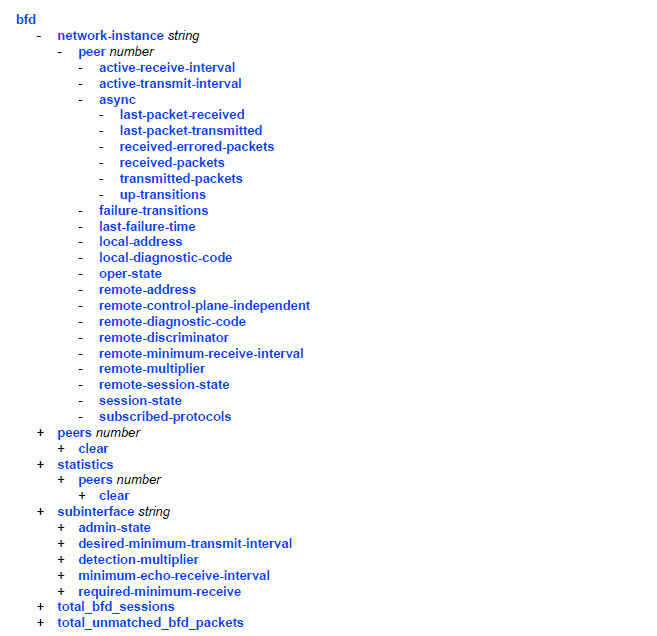Overview
This overview describes the structure of the configuration and state data models available for the Nokia Service Router Linux (SR Linux). It includes an introduction to the tree hierarchy and details how to interpret field descriptions.
Tree hierarchy
The tree hierarchy consists of branches that show the fields and parameters that are available. Tree hierarchy example shows a tree hierarchy example.

Each chapter of this guide describes a branch in the tree with field names linked to their corresponding descriptions. These descriptions indicate the required syntax for each field. See Field descriptions for more information.
Italic names after a field indicate the parameter type. Parameter types include (but are not limited to):
Boolean (true and false values)
keyword (enumerated values)
string
number
IPv4 prefix
IPv6 prefix
IPv4 address
IPv6 address
MAC address
For more information about the input values, click the field or parameter name in the tree. The link will take you to the description where these values are defined.
A parameter type may also be a combination of different base types. These parameters are displayed in the tree with the individual parameter types enclosed in round brackets and separated by a pipe. For example: (keyword | number)
Transaction and report types
The following transaction and report types are used with the SR Linux:
configuration transactions
state transactions
show reports
Configuration transactions allow you to modify a configuration while state transactions allow you to view the configuration and operational state.
In the tree hierarchy, configuration transactions are denoted with a plus sign (+). State transactions are denoted with a minus sign (-). See Configuration/state in tree hierarchy.

Each field description has a field called ‟Configurable”. The field is set to either:
true (for configuration transactions)
false (for state transactions)
Show reports are Python plug-ins used to create custom output. A set of pre-defined show reports are provided and described in the SR Linux System Management Guide. These pre-defined reports can be used as examples for how to create additional custom reports.
Hardware platform designation
The platforms field is used to define the hardware platforms that are valid for a transaction. If a transaction is only valid on specific platforms, the designation is similar to the following:


Field descriptions
Syntax for each field is displayed in bold, followed by supported parameters and their type. In the example that follows, the bfd network-instance field shows that the parameter type is a string:
- bfd
- network-instance string
Field descriptions describes valid fields for commands. Not all fields are applicable for all commands.
Field |
Description |
|---|---|
Context |
Configuration path to the command |
Tree |
Defines the commands location in the tree hierarchy |
Description |
Describes the command |
Configurable |
Indicates if the command can be configured (true) or if it is a view-only state command (false) |
String Length |
For a string, indicates a range (number of characters allowed) |
Range |
For a number, indicates the range of allowed values |
Default |
Default value |
Units |
Base unit type |
Options |
Enumerated values allowed |
Reference |
Reference to an instance in the configuration needed before the configuration is considered valid |
Max Element |
For lists and leaf-lists, the maximum number of elements |
|
Platform |
Defines the supported hardware platforms |
References
A description of each parameter is also available from the online CLI help function. See the SR Linux System Management Guide for information on using the CLI help.